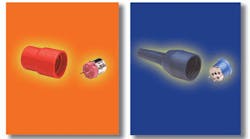All pressurized HVACR systems can eventually leak refrigerant. Therefore, it's the responsibility of the HVACR technician to monitor systems regularly and inspect for leaks.
Although a tight system — with minimal leakage that doesn't affect system performance — may not pose a problem, a more serious leak will do so, and could occur at any time.
Some leaks are plainly visible to the eye. These include a visible line break, the presence of oil, and quite possibly a refrigerant vapor cloud of escaping gas.
An audible leak might also be detected if a system is pressurized and large leaks are present.
Many Improvements
Leak detection has become greatly enhanced through the use of modern instruments designed to detect very small amounts of refrigerant and leakage.
When a technician has difficulty determining the source of a reduced refrigerant charge, additional detection methods are needed. There are various methods of leak detection, and more than one method may be necessary to conduct a thorough system diagnosis.
When verifying a refrigerant charge, any system appearing low should be suspected of leakage. Topping off the charge is generally acceptable when single (pure) compound refrigerant systems are serviced. However, it isn't acceptable for zeotropic refrigerant blends (blends of two or more components whose equilibrium vapor-phase and liquid-phase compositions are different at given pressures). When vapor leakage occurs, a variation or percentage of the refrigerants in the blended compound is compromised. Recovery of the charge, repair of the system and re-charging with renewed or virgin refrigerant is needed.
The “standing hold” method is often performed on new systems after assembly, but before the final full charging with refrigerant. The Environmental Protection Agency (EPA) allows for a trace amount of R-22 (to about 10 psig) to be added as a detectable gas.
Pressure is increased in the system with dry nitrogen to the low side working maximum pressure (typically 100-150 psig). Pressure is then monitored using a pressure gauge for several hours or longer as needed. If the systems being tested already has been charged, then recovery and evacuation of the refrigerant is done before this test.
Minor changes in temperature generally don't affect the pressure indication of nitrogen, as the same temperature variation would affect a refrigerant pressure-to-temperature relationship. This is a reliable but time consuming method of leak detection. On existing systems, the refrigerant operation must also be shut down during the test. If a leak is detected, it must be found, and often additional methods and tools are needed.
Remember that the service ports can be a leak site. These should be checked after attaching the gauge hoses. Also, remember to check the manifold gauge set for leakage.
The isolation method is used in addition to the standing hold test when areas of the system or tubing can't be accessed. This method requires breaking open the refrigerant piping system (after the charge has first been removed), then re-sealing it and pressure-testing it for leakage.
Bubbling liquid solutions are liquid solutions that bubble up when placed on a leak site. The solution can be applied by spray, dabber, brush, or immersion. A technician can use this method to verify specific leakage points when other methods indicate a general area. The solution can be a messy procedure, and requires time-consuming clean up to remove residue unless the product manufacturer indicates the solution is not damaging or corrosive.
Halide torch method. This method is used for detecting chlorinated refrigerant leaks of one ounce per year or less. Air is drawn over a copper element heated by a hydrocarbon fuel. If halogenated refrigerant vapors are present, the flame changes from a blue color to a bluish green color.
Safety Precaution: With an open flame, additional safety must be considered to prevent property damage, burns, fire, and inhalation hazards. Make sure the area is also absent of combustible mixtures and other flammables.
With the dye injection method, a dye is injected into the refrigerant-charged system. It will seep out of system cracks, and is then usually detectable. A fluorescent type dye, if used, is detectable under ultra-violet light. This also requires access to all areas of the system, as they need to be inspected for dye leakage indicators. The system may also have to operate for several hours before the leak is detected. Determine first if the compressor manufacturer allows dyes to be used on the system during the warranty period, because moisture contamination is possible.
This method requires some time consuming clean up.
Ultra-sonic devices are used to listen for leaks. These will amplify leak noises caused by leaks. Since many ambient noises may be present, there are limitations to using this detector. It's most effective when the surrounding area is very quiet.
Electronic Refrigerant Leak Detectors and Methods
Other methods include portable, hand-held electronic devices, and fixed system monitors. These are recognized as the quickest, cleanest methods.
A question that's commonly asked is, “Are leak detectors helpful in detecting leaks with all of the new refrigerants and R-22 replacement blends?” With the influx of new refrigerants, following the Environmental Protection Agency-mandated phase-out of chlorodifluoremethane (R-22) and other mandates for CFCs, HCFCs and HFCs, detection products and methods continue to be a challenge. With that in mind, many instrument companies have developed and improved their products to meet the current and even future needs with the refrigerant evolution.
Superior Sensing Devices
State-of-the-art leak detectors are able to identify all CFCs, (those containing chlorine), HCFCs (those containing fluorine) and HFCs (non-ozone-depleting refrigerants and compounds), plus bromine gas (found in HBFCs) and halogens. A superior portable leak detection tool will accurately detect and may identify the smallest of leaks. The ability to target the gases and the severity of the leak is the key to a great detection device. Reliability, longevity, serviceability, and cost should also be considered, yet initial cost alone may not be the best deciding factor.
Detector sensing devices to consider include:
Corona. This is a charged electrode which causes a charged “corona” or “corona arc”. As refrigerant contacts the corona or arc, the charge is broken and the response is indicated on the detector. This detector can be easily contaminated by dust, dirt, oils, and moisture. False signals can also be caused by those same contaminates as well as by high hydrocarbon exposure, smoke, or electrical interference.
A heated diode uses a heated sensor. When it's exposed to refrigerant gases, electrical resistance is interrupted, which sends a signal to the instrument. The reading tells the technician the severity of the leak. Heated diode sensors have an enhanced sensitivity to HFC and HCFC gases. They're built to withstand high concentrations of refrigerant gases, and they clear quickly. This unit typically works well on all refrigerants and blends.
Infrared detectors are moderate- to higher-priced, yet they have a longer sensor life, and pose minimal problems. These detectors emit infrared light energy through a chamber towards an infrared detection target. A filter produces a unique light spectrum. Gases are drawn across the spectrum and energy is absorbed by the chemical. This decreases the amount of light reaching the end of the camber, where an infrared detector senses a temperature change.
This type of detector works well on all refrigerants and blends with minimal false indications.
Key to Infrared Functionality
Getting the refrigerant to pass over the sensing element is a key to accurate infrared detection. A displacement pump or fan is often used to provide quick response. Sufficient power is needed for detectors to function correctly, and operational sensors are required. Sensitivity adjustment to refrigerants and to background contamination are a consideration with electronic leak detection. Manually adjustable devices can also be adjusted by the technician.
Some detectors have self-zeroing functions and can be adjusted for background gases. The technician should understand if a detector's sensitivity level can be made manually, or if the unit is self zeroing.
Today's detectors are valued tools, especially when combined with the technician's patience and technical expertise. However, it's also important that the technician read and follow the directions, and ask questions as needed.
Also, remember that manufacturer support is usually easy to find.
Ken Kimball is a certified HVACR specialist in heating, refrigeration, gas detection, and energy conservation. He's instructed programs across North America. He has served with the Bacharach Institute of Technical Training for 10 years. Ken and his wife Sue Kimball are owners of ksKimball, Rapid City, SD. ksKimball provides HVACR instruments, CO detection and combustion instruments, calibration and training. He can be reached at [email protected].
A Sampling of Leak Detector Manufacturers
- Bacharach Inc., Pittsburgh PA; 800/736-4666; bacharach-inc.com;
- CPS Products, Hialeah, FL; ; 800/277-3808; cpsproducts.com
- Fieldpiece, Anaheim, CA; 714/634-1844; fieldpiece.com
- Fluke, Everett, WA; 800/443-5853; fluke.com
- General Tools & Instruments Co., NY, NY; 212/431-6100; generaltools.com
- Inficon, E. Syracuse, NY; 315/434-1100; inficon.com
- UEI, Beaverton, OR; 800/547-5740; ueitest.com









